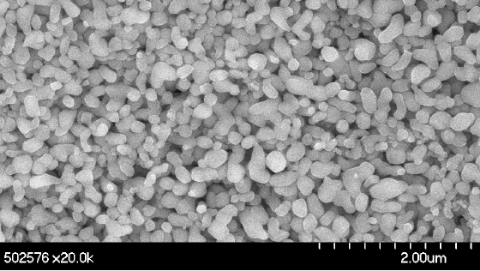High-Purity Titanium Oxide (Titanium Dioxide)
High-purity titanium oxide powder with a purity level of 3N or higher
Our high-purity titanium oxide is produced by the vapor-phase oxidation method. In the method, titanium tetrachloride, a chloride of titanium, is vaporized and then oxidized with oxygen to produce titanium oxide. Our advantage is that we can produce high-purity titanium oxide at the 3N or 4N level by using high-purity titanium tetrachloride refined for titanium metal refining as a raw material.

Purposes of use
Our high-purity titanium oxide is processed into barium titanate at our customers’ sites and used in various electronic parts. Furthermore, our high-purity titanium oxide is used as additives for optical lenses, pharmaceutical products, foods, etc., given its high purity. Our high-purity titanium oxide production process is the only one that has obtained a pharmaceutical manufacturing license and a food additive manufacturing license among Japanese titanium oxide manufacturers.
-
Electronic parts
- Multi-layer ceramic capacitor (MLCC)
- PTC thermistor
- Filter
- Piezoelectric components
-
Other
- Optical
(Additives for lenses with a high refractive index) - For pharmaceuticals and foods
(For coating agents and color adjustment)
- Optical
Specs
1. For Electronic parts
(%)
| Grade | TiO2 %min. |
Al %max. |
Fe %max. |
Cl %max. |
Rutile content %min. |
Ignition loss %max. |
Specific surface area m2/g |
Average size μm |
|---|---|---|---|---|---|---|---|---|
| HT0110 | 99.9 | 0.001 | 0.001 | 0.01 | 90 | 0.08 | 1 – 2 | <10 |
| HT0210 | 99.9 | 0.002 | 0.002 | 0.01 | 90 | 0.25 | 2 – 3 | 2.10 – 2.55 |
| HT0514 | 99.9 | 0.002 | 0.002 | 0.025 | 90 | 0.25 | 6 – 7 | – |
| HT1311 | 99.9 | 0.002 | 0.002 | 0.045 | 80 | – | 8 – 14 | – |
| HT1701 | 99.9 | 0.002 | 0.002 | 0.05 | – | – | 15 – 20 | – |
| HT2321 | 99.9 | 0.001 | 0.001 | 0.13 | – | – | 20 – 27 | – |
In addition to the above, small particle size products (PDF: 362 KB), pherical products (PDF: 251 KB) and other developed products are available. Please feel free to contact us for more information.
2. For pharmaceutical additives
| Grade | TiO2 %min. |
Pb ppm max. |
As2O3 ppm max. |
Water solubility mg max. |
Specific surface area m2/g |
|---|---|---|---|---|---|
| NA61 | 99.0 | 10 | 10 | 2.0 | 8 – 10 |
3. For food additives
| Grade | TiO2 %min. |
Pb μg/g max. |
As2O3 μg/g max. |
Water solubility %max. |
Ignition loss %max. |
Specific surface area m2/g |
Hydrochloric acid soluble material %max. |
|---|---|---|---|---|---|---|---|
| NA61 | 99.0 | 10 | 1.3 | 0.25 | 0.5 | 8 – 10 | 0.5 |
4. For materials to be added to glass and lens
| Grade | TiO2 %min. |
Al | Fe | Cr | Ni | Mn | Co | Cu | Rutile Content %min. |
Specific surface area m2/g |
Average size μm |
|---|---|---|---|---|---|---|---|---|---|---|---|
| ppm max. | |||||||||||
| HT0110 | 99.9% | 10 | 90 | 1 – 2 | <10 | ||||||
5. 4N products
| Grade | TiO2 %min. |
Al | Fe | Si | Sn | As | Ni | Cr | Cu | Cl | Rutile Content %min. |
Average size μm |
|---|---|---|---|---|---|---|---|---|---|---|---|---|
| ppm max. | ||||||||||||
| HT0270 | 99.99 | 5 | 10 | 5 | 5 | 5 | 5 | 5 | 5 | 100 | 90 | 2.16 – 2.96 |
